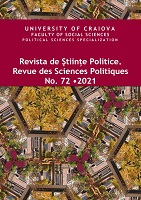The Evolution of the Post-Cold War International Relations System. Bipolarity
The Evolution of the Post-Cold War International Relations System. Bipolarity
Author(s): Daniela Alina Mic (Mărgineanu)Subject(s): Diplomatic history, Political history, International relations/trade, Security and defense, Transformation Period (1990 - 2010)
Published by: Editura Universitaria Craiova
Keywords: security; bipolarity; unipolarity; system of international relations;
Summary/Abstract: Throughout time, the evolution of international relations has mostly been dominated by the distribution of power within the system of international politics. Therefore, the decade following the year 1990 can be characterized as a period of development of democratic norms and institutions, in which the American triumph represented the central point of the entire international political system that governed the next historical period. An important aspect of the system has been the power distribution by emphasizing the term polarity as a configuration of the structure of international relations according to the number of the state actors. Polarity means exactly a supposed distribution of power and that is why, in the current vocabulary of international relations, we can refer to alternative structures of the international system of bipolar, unipolar, multipolar nature. Consequently, the configuration of power forces or power poles is an essential element that has been used for several decades in order to define the structure of the international system. If we analyze the situation for this period from a security point of view, there has been recorded a flurry of controversy, thus some authors have mentioned the new created environment as a unipolar one, while others see it as multipolar: in his work "The Unipolar Illusion": “Why New Great Powers Will Arise?” (1993) V. Layne, stated that the international system is not a multipolar one, but is characterized by a “unipolar moment”. At a certain point in history, unipolarism could find in the United States the only center acknowledged internationally as a worldwide authority, and yet we could say that unipolarism has often been counterbalanced by multipolarism, as a revival of some countries which have lately proved their superiority and influence several times. On the other hand, the distribution of polarity power within the system is undoubtedly the most important feature, which involves its stability as well.
Journal: Revista de Științe Politice. Revue des Sciences Politiques
- Issue Year: 2021
- Issue No: 72
- Page Range: 182-193
- Page Count: 12
- Language: English

